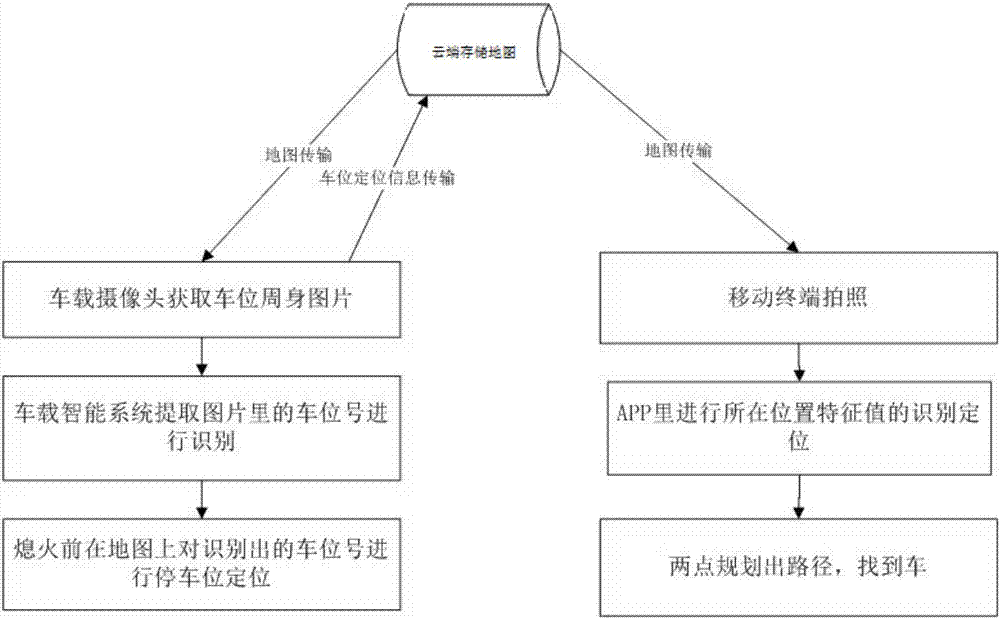Positioning and vehicle searching system, positioning and vehicle searching method and location positioning method
An intelligent system and vehicle positioning technology, applied in the direction of road vehicle traffic control system, traffic control system, instruments, etc., can solve problems such as difficulty in finding a car, inability to obtain parking space information, inability to find parking spaces, etc., to avoid intervention, avoid Effects of forgetting operations
- Summary
- Abstract
- Description
- Claims
- Application Information
AI Technical Summary
Problems solved by technology
Method used
Image
Examples
Embodiment 1
[0067] Positioning and car finding system, including:
[0068] The vehicle-mounted intelligent system comprises a parking space information collection device, a vehicle identification system, a vehicle-mounted communication module, a visual odometer and an inertial navigation system, and the parking space information collection device is used to collect parking space feature image information; the parking space information collection device selects a vehicle-mounted camera, preferably The surround view camera (the front view camera can also be used) collects the parking space number information. For example, if the 3DAVM parking system is adopted, the signals captured around the car can be seamlessly spliced by carrying four ultra-wide-angle cameras on the body. The on-board recognition system is used to identify the characteristic image information of the parking space, and according to the identified parking space information, locate on the parking lot map of the on-board i...
Embodiment 2
[0086] Scheme is identical with embodiment 1, as figure 1 As shown, the difference:
[0087] Position the vehicle:
[0088] (1) After the vehicle arrives at the garage and parks in the parking space, the parking space feature image information is collected through the parking space information collection device of the vehicle intelligent system;
[0089] (2) The on-board recognition system of the on-board intelligent system recognizes the characteristic image information of the parking space;
[0090] (3) according to the characteristic image information of the parking space identified, positioning is carried out on the parking lot map of the vehicle-mounted intelligent system to form a positioning one;
[0091] (4) Position the vehicle where the vehicle is parked through the visual odometer combined with the inertial navigation system to form a positioning 2;
[0092] (5) Fusion the two positions of positioning 1 and positioning 2 to obtain accurate vehicle positioning inf...
Embodiment 3
[0100] The relevant technical principles involved are the same as in Embodiment 1, and the specific scheme:
[0101] Position the vehicle:
[0102] (1) The mobile terminal locates the vehicle through the visual odometer combined with the inertial navigation system to form a vehicle positioning system;
[0103] (2) The mobile terminal uses the information collection device to collect the characteristic image information of the location of the vehicle;
[0104] (3) The mobile terminal identification system identifies the characteristic image information of the location of the vehicle;
[0105] (4) Positioning on the map according to the characteristic image information of the vehicle location identified by the mobile terminal to form a vehicle location 2;
[0106] (5) The mobile terminal fuses the two positions of vehicle positioning 1 and vehicle positioning 2 to obtain accurate vehicle positioning information;
[0107] Locate the user's location when looking for a car:
[01...
PUM
 Login to View More
Login to View More Abstract
Description
Claims
Application Information
 Login to View More
Login to View More - R&D
- Intellectual Property
- Life Sciences
- Materials
- Tech Scout
- Unparalleled Data Quality
- Higher Quality Content
- 60% Fewer Hallucinations
Browse by: Latest US Patents, China's latest patents, Technical Efficacy Thesaurus, Application Domain, Technology Topic, Popular Technical Reports.
© 2025 PatSnap. All rights reserved.Legal|Privacy policy|Modern Slavery Act Transparency Statement|Sitemap|About US| Contact US: help@patsnap.com

